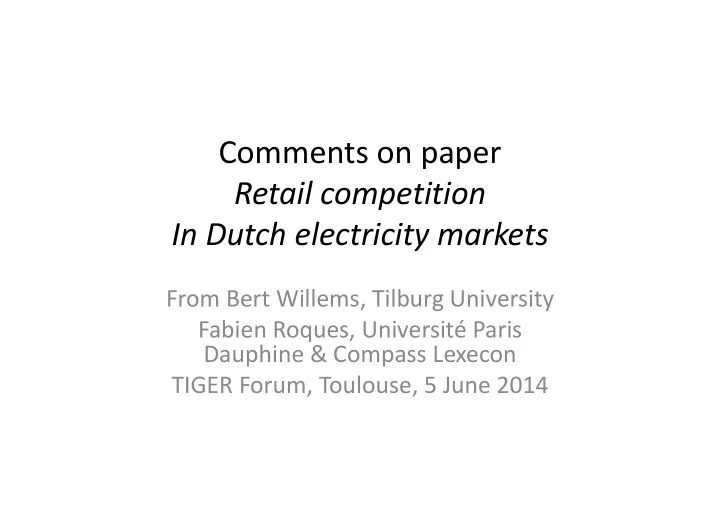

Comments on paper Retail competition In Dutch electricity markets From Bert Willems, Tilburg University Fabien Roques, Université Paris Dauphine & Compass Lexecon TIGER Forum, Toulouse, 5 June 2014
Paper objectives and context Two main parts: • – Review of Dutch retail electricity market – Empirical study of retailers pricing strategies: focus on pass ‐ on changes in the wholesale energy price to retail consumers Noticeable facts about the Dutch retail market: • – Retail market relatively concentrated. Three largest retailers have about 80% of market (Essent, Nuon, Eneco) – Two new entrants (Nem, Greenchoice) with low market shares – GDF ‐ Suez & E.ON large firms in production, but small market shares in retail Retail products differentiation in the Dutch market: • – High switching rates compared to other countries ( 13% / year), but 45% of households has never switched retailer. – Strong demand for Green electricity (63% of contracts)& dual fuel contracts – Coexistence of fixed ‐ price & variable ‐ price contracts – Contracts with fixed (1,2,3 or 5 years) or of undetermined duration
Methodology and results Dataset: anonymized data collected by the Dutch energy regulator over Jan 2007 ‐ 2011 • Observations from dataset: Forward price is highly correlated with the spot price, but not • with the realized spot price Same underlying drivers for the spot and the forward price – Retail price follows the forward price with a delay – Consistent with previous studies on other electricity & commodity markets – Three step econometric approach: estimates unit response functions which specify retail • price reaction to forward retail price shocks 1. Regress current changes of the retail prices on past changes in the forward price and past changes of the retail price work with first differences; number of lags determined with the Schwarz information criterion – 2. Simulate the step ‐ response function A 1 EUR/ MWh price change in the forward price will, on average, lead to a price change of 32 EUR – cents /MWh in the retail price (and 35 EUR cents / MWh in the estimation with 2 lags). 3. Test whether prices respond asymmetrically to price increases and price decreases Quicker & stronger response to an increase in the forward price than to a decrease in the forward – price
Discussion & some random suggestions for further research Research concentrates on fixed ‐ price, gray contracts for a duration of 1 year • Most competitive market, one year product allows use of more liquid forward markets – => Extension to other products, such as green tariffs and /or dual price tariffs would be interesting to test impact of competition / product specialization => In practice retailers charge consumers two ‐ part prices: are there different strategies to determine the fixed part /its evolution? Papers makes some assumptions that could be relaxed / tested • Assumes that retailers buy forward contracts on the wholesale market that exactly offset their retail – obligations, and do not buy electricity in the spot market => In reality sourcing strategy => Paper could test impact of different sourcing strategies involving a mix of forward contracting with different time frames, and leaving some exposure to spot market Paper assumes that retail prices are based on current and past forward prices – => In reality market players form their own view of wholesale market evolution which may imply a different view on forward price Paper does not look at evolution of retail mark ‐ ups over time • => interesting issue to investigate: impact of mergers & increase in market concentration in 2010 ‐ 2011? => frequency of price adjustments differs across firms, can a price leader b e identified? (Edgeworth type competition)
Recommend
More recommend